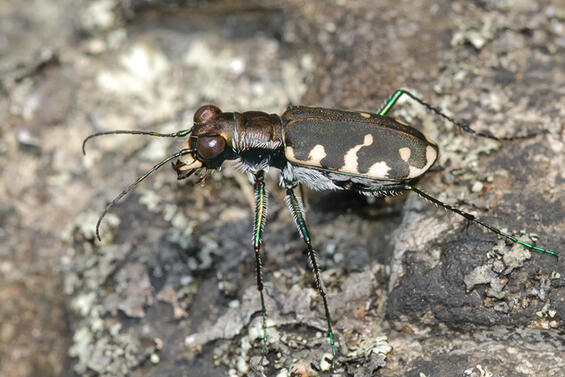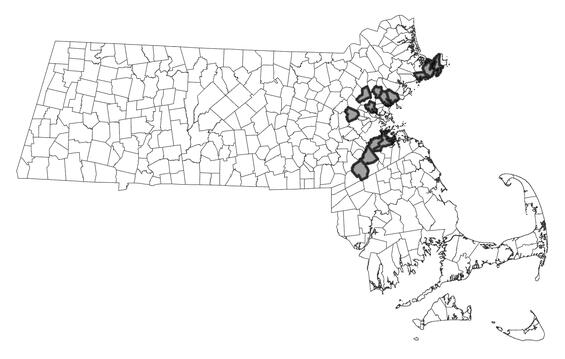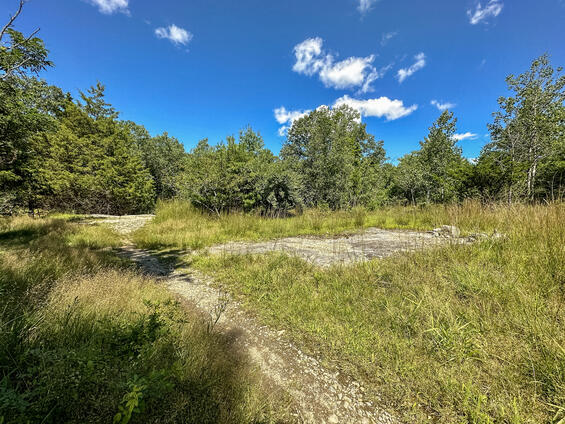- Scientific name: Cicindelidia rufiventris hentzii
- Species of Greatest Conservation Need (MA State Wildlife Action Plan)
- Threatened (MA Endangered Species Act)
Description

Hentz’s red-bellied tiger beetle (Cicindelidia rufiventris hentzii)
Tiger beetles are so named because of their “tiger-like” behavior of chasing down and capturing prey with their long mandibles. Hentz's red-bellied tiger beetle (Cicindelidia rufiventris hentzii) is 9-12 mm (0.4-0.5 in) in length (Pearson et al. 2015). It is dark brown in color, with a copper sheen, particularly on the head and thorax. Hentz's red-bellied tiger beetle has white maculations (markings) on the elytra (wing covers) that are broader and more extensive as compared to the nominate subspecies, the eastern red-bellied tiger beetle (Cicindelidia rufiventris rufiventris). Both subspecies have an abdomen that is bright orange in color, typically only visible when the elytra are raised for flight.
Life cycle and behavior

Hentz’s red-bellied tiger beetle has a one-year life cycle (Leonard & Bell 1999). Adult beetles are active in July and August, when they forage, mate, and females lay eggs. Larvae presumably burrow in soil, moss, and lichens in cracks in the bedrock (Leonard & Bell 1999). Larvae overwinter and complete development in spring and early summer.
Distribution and abundance
Hentz’s red-bellied tiger beetle is endemic to Massachusetts, occurring on bedrock outcrops in the hills around Boston, Massachusetts, and extending north to Gloucester.

Distribution in Massachusetts. 2000-2025. Based on records in the Natural Heritage Database.
Habitat
Hentz’s red-bellied tiger beetle inhabits sparsely vegetated bedrock outcrops, often of granite composition.
Healthy habitats are vital for supporting native wildlife and plants. Explore habitats and learn about conservation and restoration in Massachusetts.

Sparsely vegetated bedrock outcrop, habitat for Hentz’s red-bellied tiger beetle. Habitat managed by DCR at Middlesex Fells State Reservation.
Threats
Hentz’s red-bellied tiger beetle is threatened by habitat loss and suppression of fire, which is needed to maintain the open vegetation structure of its habitat. Other potential threats include invasive exotic plants, aerial insecticide spraying, and off-road vehicles. This species has an unusually small geographic range, which may make it especially vulnerable to climate change. Its ability to shift or expand its range in response to climate change, or to adapt within its current range, is not known.
Conservation
Land protection and habitat management are the primary conservation needs of Hentz’s red-bellied tiger beetle in Massachusetts. In particular, sparsely vegetated bedrock outcrops in Norfolk, Suffolk, and southeastern Middlesex and Essex counties should be conserved, restored, and managed to maintain habitat for this species and other species dependent on such habitat.
Survey and monitoring
The distribution of Hentz’s red-bellied tiger beetle is relatively well documented, though undocumented or newly colonized sites may yet be discovered. Known populations should be surveyed to document persistence at least once every 25 years; every 10 years is more desirable when practicable.
Management
Management of sparsely vegetated bedrock outcrop habitats benefits a diversity of species, including Hentz’s red-bellied tiger beetle. Restoration and maintenance of sparse native vegetation and control of invasive exotic plants are of primary importance. Habitat condition should be monitored and management adapted as needed.
Research needs
The basic natural history and conservation needs of Hentz’s red-bellied tiger beetle are relatively well known. However, the details of this species’ life history, in particular the immature stages, need further study. In addition, the future effects of climate change on this species are unpredictable and should be documented.
References
Leonard, J.G. and R.T. Bell. 1999. Northeastern Tiger Beetles: A Field Guide to Tiger Beetles of New England and Eastern Canada. CRC Press, Boca Raton, Florida. 176 pp.
Pearson, D.L., C.B. Knisley, D.P. Duran, and C.J. Kazilek. 2015. A Field Guide to the Tiger Beetles of the United States and Canada. Oxford University Press, New York, New York. 251 pp.
Contact
| Date published: | April 16, 2025 |
|---|